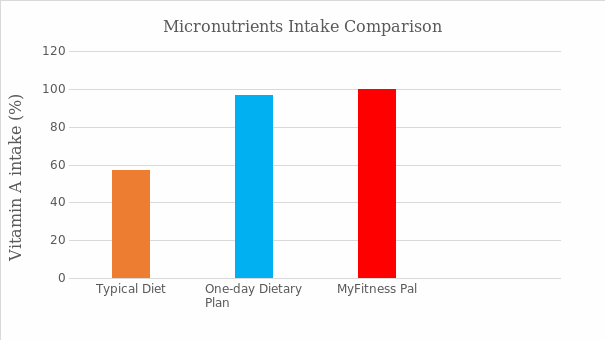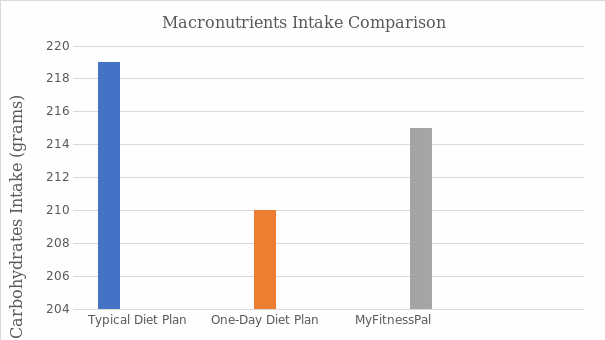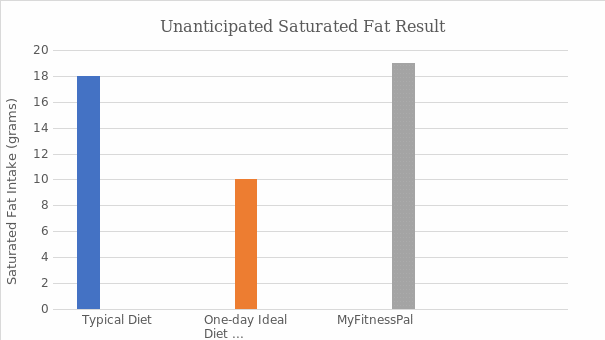Introduction
An ideal diet plan is of great significance since it helps manage one’s weight and improve the body’s immunity. Several foods are advised to be taken under certain limits daily, such as a variety of proteins, fruits, whole grains, vegetables and low sugars, sodium, cholesterol, saturated fats, and low-fat milk. Every diet is meant to meet specific nutritional goals therefore, this paper aims to design a one-day ideal diet plan to achieve dietary goals: daily intake of micro and macronutrients.
Goal Achievement: Micronutrients Intake
Micronutrients are nutrients that the body needs, including Vitamins, minerals, etc. Vitamins are required for energy synthesis, immunological function, blood coagulation, and various other processes (Sobotka & Forbes, 2019). Micronutrients serve an essential role in metabolism and tissue function maintenance. Micronutrients are vitamins and minerals that the human body needs in minute amounts. They are responsible for various tasks, including enabling the enzymes, hormones, and other chemicals produced by the body required for optimal development and growth (Savarino et al., 2021). Any person can have micronutrient deficiency, although children and pregnant women are at the highest risk of developing deficits. As a result of poor diet, higher physiological necessities as pregnancy and childhood development often increase the need for specific vitamins and minerals (Savarino et al., 2021). Micronutrients that are essential include (but are not limited to) Iron, zinc, iodine, vitamin A and B – vitamins.
As seen in the table above, the average three-day vitamin A intake is 57% compared to the MyFitnessPal goal, which is 100%. Under such a case, the vitamin A intake will be deficient, leading to vitamin deficiency disorders; hence there needs to be corrected to the required amount. In the one-day ideal dietary plan, the vitamin A intake is fixed to 97% to achieve the MyFinessPal daily goal hence meeting the body’s vitamin requirement as they are needed in high amounts to improve immunity. Below is a graphical presentation of a one-day diet plan for Vitamin A intake in comparison to the MyFitnessPal daily goal and Three-day typical diet.

The above graph explains the micronutrient intake correction, specifically Vitamin A, in a One-day dietary plan. To achieve the One-day Vitamin A dietary plan, its intake has to be from different sources. Preformed vitamin A concentrations are highest in the liver, fish, eggs, and dairy products. In the United States, most dietary provitamin A is obtained from leafy green vegetables, orange and yellow vegetables, tomato products, fruits, and some vegetable oils (Savarino et al., 2021). Some foods, such as magarine and milk, are frequently fortified with vitamin A. Some ready-to-eat cereals are also vitamin A. Preformed vitamin A accounts for around 65 to 80 percent of vitamin A taken in the United States and other high-income nations (Savarino et al., 2021). Provitamin A is the predominant form consumed in low-income countries, whose diets include more plant-based foods. Enriched and fortified foods account for 34–40% of vitamin A consumption from food among children and adolescents in the United States.
Although increasing vitamin A intake in a one-day dietary plan is essential for the body, its excess information can also be harmful. Because vitamin A is fat-soluble, excess amounts are stored in the body, mainly in the liver, and these levels can build. Acute vitamin A toxicity, also known as hypervitaminosis A, occurs within days to weeks of ingesting a few substantial dosages (typically more than 100 times the RDA). Severe headaches, impaired vision, nausea, dizziness, aching muscles, and coordination issues are common signs and symptoms (Schmidhuber et al., 2018). Cerebral spinal fluid pressure can rise in severe cases, causing sleepiness, coma, and even death. Chronic hypervitaminosis A (consistently consuming high amounts) can result in dry skin, achy muscles and joints, weariness, depression, and abnormal liver test findings.
In addition, excessive preformed vitamin A intake and some retinoid drugs used as topical therapies can result in congenital birth abnormalities. Birth abnormalities can include eye, skull, lungs, and heart anomalies. Experts advise those who are pregnant or may become pregnant, as well as those who are nursing, not to use large dosages of vitamin A supplements (more than 3,000 mcg RAE [10,000 IU] daily) (Savarino et al., 2021). Unlike preformed vitamin A, Beta-carotene is not known to be teratogenic or cause reproductive damage. Carotenodermia, a harmless disorder in which the skin turns yellow-orange, is the most prevalent side effect of long-term beta-carotene excess.
Macronutrients Intake
Macronutrients are essential components needed in large amounts in the body, including proteins, carbohydrates, and fats. All carbohydrates are finally converted into glucose, which is the body’s primary energy source. In reality, specific organs, such as the brain, require glucose to function correctly (Sobotka & Forbes, 2019). Aside from being the primary energy source, carbohydrates aid in synthesizing particular amino acids (protein building blocks) and maintaining regular bowel motions. Fiber is a kind of carbohydrate which the Gastrointestinal tract cannot break down. As a result, while this vitamin does not provide energy, it does assist in removing waste from the body and maintaining a healthy intestinal tract (Schmidhuber et al., 2018). Carbohydrates are not all the same; some are classified as simple carbohydrates, while others are classified as complex.
Regarding the data in table 1, carbohydrates intake in the Three-Day typical diet is higher than the MyFitnesspal daily plan, whereby its 219grams and 215grams respectively. In the one-day dietary program, the total carbohydrate intake is reduced to 210 to prevent less or excessive consumption. The three-day carbohydrate typical diet is more than the required set intake amount hance can bring some disorders such as obesity; hence reducing the amount helps meet the daily goal. The data can be well demonstrated in the below graph presentation.

Different combinations can help achieve various aims or manage multiple disease states. Because each person thrives at a different proportion, what works for one person may not work for everyone. Downloading a tracking app can assist in locating and following one’s location. MyFitnessPal is a fantastic free tool that can be used on both desktop and mobile devices to track daily intake and see macronutrient levels (Schmidhuber et al., 2018). No matter what percentages an individual picks, ensuring their kcals are adequate is always where they should begin. There is a kcal range that will assist them in succeeding whether they are attempting to lose, maintain, or gain weight.
Unanticipated Result
The one-day ideal diet plan’s fat and saturated fat intake was an unexpected result. The intake of saturated FatFat was reduced from 18 grams for the Three-day typical diet to 10grams for one -day diet plan. Compared to the MyFitnessPal daily goal of 19 grams, the intake amount has reduced dramatically, although due to several parameters such as an increase in carbohydrates. In addition, too much intake of FatFat and unsaturated is unhealthy and can bring about some conditions. Graph presentation of the unanticipated saturated fat intake can be as below:

In addition, the two main unsaturated fat categories in the diet are monounsaturated and polyunsaturated. Polyunsaturated fats have the most significant impact on decreasing harmful cholesterol levels of the two types. The majority of saturated FatFat originates from animal diets, whereas most plant oils have a combination of mono- and polyunsaturated FatFat, with one group frequently dominating the fat profile (Astrup et al., 2021). Avocados, nuts like almonds and pecans, pumpkin, and sesame seeds are high in monounsaturated fats. Meanwhile, polyunsaturated FatFat is abundant in flaxseeds, walnuts, and salmon. Furthermore, fish contains essential omega-3 polyunsaturated fats, which are the most heart-healthy fats in your diet. The American Heart Association suggests eating two fatty fish meals each week, such as salmon and mackerel.
Conclusion
One-Day Ideal Diet plan is of importance to the healthy dieting of an individual as it helps formulate specifically required nutrients for intake depending on an individual’s calories. An ideal diet plan can be structured using MyFitnessPal software or an app whereby individuals set their nutritional goals for a chosen period. This paper has presented an example of a diet plan using MyFitnessPal to classify micro and macronutrient intake in a One-Day Ideal diet plan. From the data presented, micronutrients such as vitamin A in low amounts in the Three-day average diet have been corrected to the required quantity, and carbohydrates in excess have been reduced to standard levels. Furthermore, there was an unexpected result for saturated fats as the One-day diet intake plane decreased significantly.
References
Astrup, A., Teicholz, N., Magkos, F., Bier, D. M., Brenna, J. T., King, J. C.,… & Krauss, R. M. (2021). Dietary Saturated Fats and Health: Are the US guidelines evidence-based?. Nutrients, 13(10), 3305.
Sobotka, L., & Forbes, A. (2019). Basics in clinical nutrition (Vol. 1, No. 5th). Galen.
Schmidhuber, J., Sur, P., Fay, K., Huntley, B., Salama, J., Lee, A.,… & Afshin, A. (2018). The Global Nutrient Database: availability of macronutrients and micronutrients in 195 countries from 1980 to 2013. The Lancet Planetary Health, 2(8), e353-e368.
Savarino, G., Corsello, A., & Corsello, G. (2021). Macronutrient balance and micronutrient amount through growth and development. Italian Journal of Pediatrics, 47(1), 1-14.